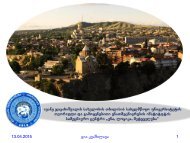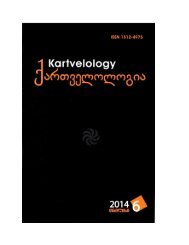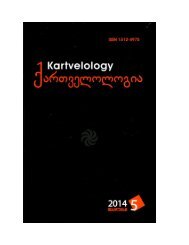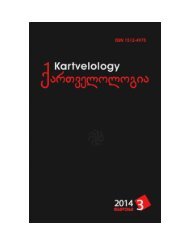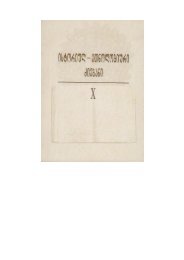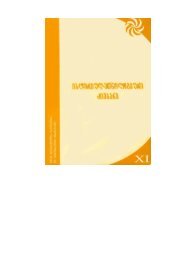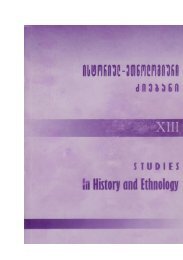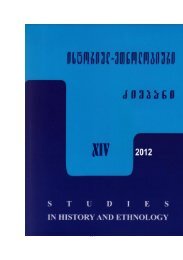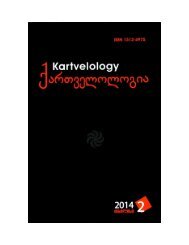Kvashilava, Gia, 2010. On Reading Pictorial Signs of the Phaistos Disk and Related Scripts (2). Rosette (in Georgian and English)
This study concerns the graphic character, symbolic meanings, typological parallels, commentaries and reading of the Phaistos Disk pictorial sign PHD38.
This study concerns the graphic character, symbolic meanings, typological parallels, commentaries and reading of the Phaistos Disk pictorial sign PHD38.
Create successful ePaper yourself
Turn your PDF publications into a flip-book with our unique Google optimized e-Paper software.
(PSD; Black, Green 1992, 109; MPW 1991, I, 595; 1992, II,<br />
197); <strong>the</strong> latter is identified with <strong>the</strong> planet Venus (Williams-<br />
Forte 1983, 176; Piška 2003, 4; Kasak, Veede 2001, 14, 22-24;<br />
Kurtik 1999, 502, 502 4 , 503; Coll<strong>in</strong>s 1994, 110, 115; MPW<br />
1991, I, 510, 595). Venus is <strong>the</strong> Morn<strong>in</strong>g Star. It‟s also known<br />
as <strong>the</strong> Even<strong>in</strong>g Star.<br />
The sacred number <strong>of</strong> Inanna or Ishtar is 15 (Kasak,<br />
Veede 2001, 23).<br />
The symbols <strong>of</strong> Aya <strong>and</strong> Inanna or Ishtar are: an eightpetalled<br />
rosette (Maxwell-Hyslop 1971, 151, 152; Black,<br />
Green 1992, 109, 156, 169-170; Aleff 1982-2009, 4; MPW 1991,<br />
I, 510; Ad de Vries 1981, 391-393; Herder 1980, 134); an eightpetalled<br />
sign ; a double cross (Herder 1980, 93); eightpo<strong>in</strong>ted<br />
stars: , , , , , , (Maxwell-Hyslop<br />
1971, 149; Black, Green 1992, 108; Heiser 2006, 6, 12; MPW<br />
1992, II, 651; Leick 1998, pl. 38); a disk 1 , a r<strong>in</strong>g (MPW<br />
1991, I, 510; Herder 1980, 92); a double circle with an eightpo<strong>in</strong>ted<br />
star, four sharp-po<strong>in</strong>ted rays <strong>and</strong> four floral<br />
ornaments<br />
(Evans 1909, 157, P.40*); disks with eightpo<strong>in</strong>ted<br />
stars: , , , , Black, Green 1992, 169, Fig.<br />
‛ tr; Middle Egyptian ỉśtr; Phoenician ‛štrt (Gamkrelidze, Ivanov 1984, II,<br />
685, 686, 875, 875 1 ); Old Hebrew , [‛š r ] (Bible 1992, 2008,<br />
Judges 10.6; 1 Samuel 7.3-4, 12.10, 31.10; 1 K<strong>in</strong>gs 11.5, 11.33; 2 K<strong>in</strong>gs 23:13;<br />
comp. Jeremiah 44.18-19); Old Hebrew [‛šrh]; Ugaritic<br />
[‛ trt], ‛ rt; Armenian [astłik/astġik]; Old Greek – <strong>the</strong><br />
goddess Astarte (MPW 1991, I, 115); Egyptian [зst] – <strong>the</strong> goddess Isis<br />
(Collier, Manley 2007, 70, 151; MPW 1991, I, 133); Hurrian Iš ara – <strong>the</strong><br />
goddess Ishkhara (Nozadze 2007, 186); Hebrew [’es er]. Ishtar might<br />
be also connected with <strong>the</strong> Akkadian Anunitu (MPW 1991, I, 595) <strong>and</strong><br />
Hurrian d Ni·na·at·ta/ d Ne·na·at·ta (Nozadze 2007, 260).<br />
1 . “The smaller symbolic disk, as contrasted with that <strong>of</strong> <strong>the</strong> rayed solar<br />
emblem, must be taken as symbolic <strong>of</strong> <strong>the</strong> Goddess as Queen <strong>of</strong> <strong>the</strong><br />
Underworld <strong>and</strong> <strong>of</strong> <strong>the</strong> starry vault <strong>of</strong> Night” (Evans 1921, 514).<br />
258




